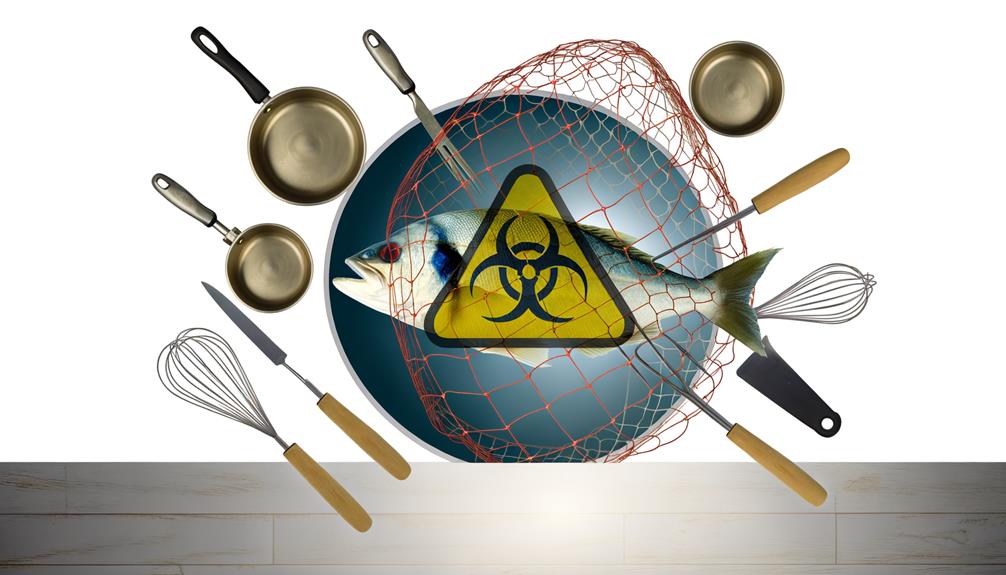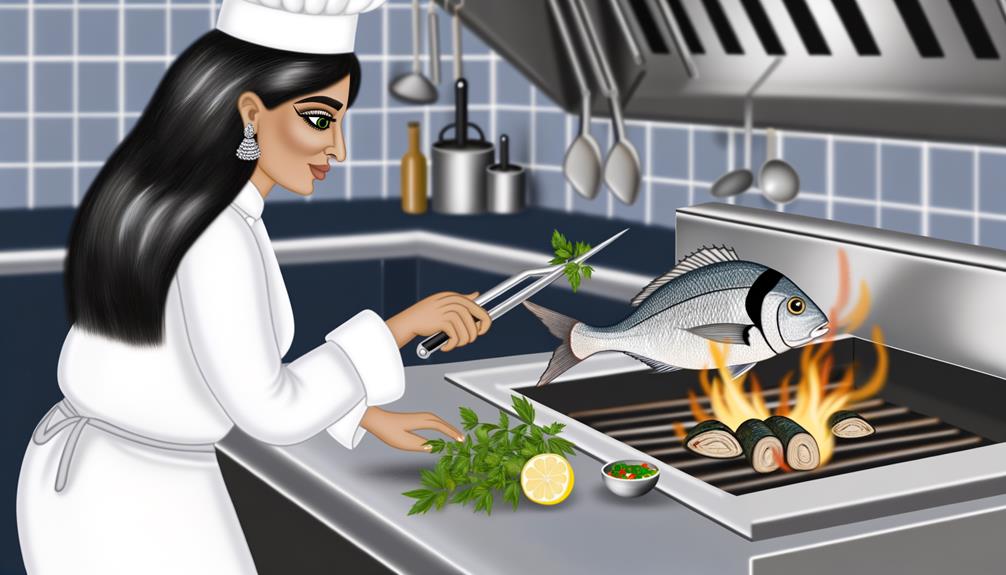The culinary value of saltwater drum fish, a species that offers a wide range of preparation methods, is a topic of ongoing discussion. Many enjoy its unique flavor and versatile texture, which can be compared to a pork chop, while others express concerns about the presence of worms in larger specimens.
To fully appreciate the gastronomic potential of this fish, one must consider not only its taste and texture but also its nutritional profile and any potential health risks. This invites a broader exploration of drum fish as a culinary option.
Key Takeaways
- Saltwater drum fish are considered good to eat due to their firm texture and mildly sweet flavor, especially when they are smaller in size.
- The fish is high in lean protein, omega-3 fatty acids, and vitamins B12 and D, providing significant nutritional value.
- Safety considerations such as potential worms, parasites, and mercury content require proper cleaning, handling, and thorough cooking of drum fish.
- Popular cooking methods for drum fish include grilling, frying, baking, and blackening, with an emphasis on sustainable fishing practices for conservation.
Understanding Saltwater Drum Fish
The saltwater drum fish, particularly the black drum, is regarded in culinary circles for its firm, dense texture and mildly sweet flavor, making it a versatile ingredient in a variety of dishes. The black drum's culinary appeal is significantly influenced by size. Smaller fish, typically under 20 pounds, are good to eat, their flesh offering a gentle, satisfying sweetness. In contrast, larger fish may lack this mild flavor, their texture potentially becoming wormy and less yielding.
The culinary potential of the black drum extends beyond its taste. This species is a staple in diverse recipes, from hearty fish stews and crispy fishcakes to delicate veal parm, its flavor often compared to the esteemed red snapper. However, the enjoyment of this fish is subjective, with some finding it unpalatable while others, particularly when well-prepared or part of a fish fry, relish its unique characteristics.
However, conservation concerns have emerged due to the black drum's slow growth rates and high commercial and recreational pressure, leading to decreasing harvested numbers. As such, the release of larger fish is recommended to sustain the population, ensuring future generations can also savor this oceanic delicacy.
Nutritional Profile of Drum Fish
Apart from its culinary potential, the drum fish also boasts a robust nutritional profile that contributes to its appeal. Rich in lean protein, a 3-ounce serving provides approximately 16 grams, making it a valuable source of this vital macronutrient. Protein is essential for muscle growth and repair, immune function, and overall body maintenance.
Moreover, drum fish is a good source of omega-3 fatty acids. These polyunsaturated fats are known for their heart health benefits and their role in maintaining optimal brain function. The fish also provides key minerals, including selenium, which contributes to skin health, and phosphorous, necessary for energy metabolism.
Drum fish further supports health through its vitamins content. High in vitamins B12 and D, it aids in red blood cell production and bolsters the immune system. These vitamins also play a role in maintaining nerve health and promoting bone strength, respectively.
Lastly, despite its nutrient density, drum fish is lower in calories compared to many other fish species. Thus, it can be an excellent choice for those watching their weight or those who simply desire a healthier diet. This makes the drum fish not only tasty but also nutritionally balanced, reinforcing its place on our plates.
Safety Concerns With Drum Fish

While drum fish, including the black drum variety, are generally safe for consumption when properly cleaned and cooked, special attention should be given to potential risks associated with worms, parasites, and mercury content. The safety concerns are increased when the drum fish is consumed raw, as it might expose the consumer to serious health risks.
Thorough cooking at the required temperature is crucial to eliminate these health risks. Moreover, proper preparation, such as the removal of scales, bones, and visible parasites, further ensures the safety of eating drum fish.
Despite these safety concerns, drum fish can be a nutritious and delicious seafood option when handled and cooked correctly. Below is a summary table for your reference:
| Safety Concerns | Mitigation Steps |
|---|---|
| Worms | Adequate cooking and visual inspection |
| Parasites | Proper cleaning and thorough cooking |
| Mercury Content | Moderate consumption |
| Bones | Careful filleting and deboning |
| Scales | Thorough scaling before cooking |
Taste and Texture Analysis
Having addressed the safety concerns associated with drum fish, it is essential to consider the culinary appeal of this seafood, particularly in terms of taste and texture. The taste of saltwater drum fish, such as the black drum, is often described as mild and slightly sweet, bearing resemblance to the flavorful profile of red snapper. This characteristic makes it a delectable choice for those who relish the subtle nuances of saltwater fish.
When assessing texture, it is noteworthy that saltwater drum fish present a meaty, moist, and flaky consistency without an overbearing oiliness. This property enhances their versatility in various cooking methods, despite the fact that this discussion is reserved for another subtopic. However, not all drum fish are created equal. Smaller drum fish, typically weighing between 5 and 15 pounds, are recognized for superior texture and flavor.
Conversely, larger drum fish can be less desirable, often exhibiting a tougher texture and harboring a stronger taste. Moreover, they are frequently riddled with worms, further diminishing their culinary appeal. Despite these drawbacks, the black drum, a member of the saltwater drum family, still finds favor in seafood restaurants along the Atlantic coast due to its unique taste and texture.
Cooking Techniques for Drum Fish

Navigating the myriad cooking techniques for drum fish, we find that grilling, frying, baking, and blackening are common methods used to showcase this species' mild flavor and firm texture. Each method plays a key role in presenting drum fish's unique culinary attributes.
- Grilling provides a smoky flavor that complements the fish's natural taste. Given the firm texture of drum fish, it retains its shape nicely when grilled, making it a popular choice for outdoor cookouts and barbecues.
- Frying is another prevalent method, often involving a light breading to enhance the fish's crispness. The internal moisture of the fish is preserved, yielding a tender and juicy result.
- With baking, the drum fish is typically combined with citrus and herbs, allowing the mild flavor of the fish to merge with these complementary tastes for a harmonious blend.
- Blackening is a classic technique that involves coating the fish in a mixture of spices before cooking it at high heat. This results in a blackened crust that packs a flavor punch.
Drum Fish Versus Other Seafood
In the realm of seafood, the black drum fish distinguishes itself with its meaty, moist, and flaky texture, earning a reputation that competes favorably with other popular choices such as the red snapper. Rich in lean protein and omega-3 fatty acids, the drum fish is not just enjoyable to eat but also contributes to good health.
Its flavor, a delicate blend of mild and slightly sweet notes, is a culinary delight, making it a favored choice along the Atlantic coast. The versatility of this fish, adaptable to various cooking methods due to its thick texture and large flakes, adds to its appeal.
Comparatively, here's a look at the black drum fish and the red snapper:
| Black Drum Fish | Red Snapper | |
|---|---|---|
| Texture | Meaty, moist, and flaky | Firm and lean |
| Flavor | Mild and slightly sweet | Mild and slightly sweet |
| Health Benefits | High in lean protein and omega-3 fatty acids | Rich in vitamins and minerals |
| Versatility in Cooking | High | Moderate |
| Popularity | High | High |
Overcoming Potential Risks

While the culinary appeal of saltwater drum fish remains high, it is essential to address certain potential risks associated with their consumption, particularly concerning size and preparation methods. Smaller drum fish, including black drum, are considered good to eat due to their improved taste and texture. In contrast, bigger fish often harbor spaghetti worms, which, while not harmful to humans when cooked, can be visually unappealing.
To ensure a safe and enjoyable culinary experience, consider the following:
- Opt for smaller ones: They are not only tastier but also less likely to contain spaghetti worms.
- Understand the slot size: Familiarize yourself with local fishing regulations to make sure you're catching fish within the legal size limits.
- Practice catch and release: For bigger fish, consider releasing them back into the water to help conserve the species and avoid potential worm issues.
- Master your cooking method: Whether you're grilling, frying, or baking, proper preparation can enhance the taste of your catch.
- Safety first: Always ensure your drum fish is cooked thoroughly to make it safe to eat.
These measures can help mitigate potential risks, ensuring you can enjoy the unique taste of saltwater drum fish without worry.
Frequently Asked Questions
What Does Saltwater Drum Fish Taste Like?
Saltwater drum fish, a choice ingredient in many drum fish recipes, offers a mild, slightly sweet flavor. Taste comparisons often liken it to red snapper. Various cooking methods and seasonings enhance its inherently delicious taste.
Is a Drum Fish Good to Eat?
Yes, drum fish are excellent for consumption. Their nutritional value is high, offering lean protein and omega-three fatty acids. They can be prepared using various cooking techniques, following numerous drum fish recipes, and are sustainably fished.
How Big Do Saltwater Drum Fish Get?
Saltwater drum fish display significant size variation, influenced by habitat conditions, predatory impacts, and reproduction effects. Their growth rate and age determination further contribute to sizes ranging up to 5 feet in length and 100 pounds.
What Are the Parasites in Drum Fish?
Parasites in drum fish, notably spaghetti worms, pose minimal health risks due to their lifecycle. Proper cooking methods and thorough cleaning prevent infection, ensuring safe consumption while maintaining the fish's culinary appeal.
Conclusion
In conclusion, despite concerns about parasites in larger specimens, saltwater drum fish remain an excellent choice for consumption due to their rich flavor and versatility in various culinary applications.
By adhering to proper cooking techniques, any potential risks can be mitigated, rendering the drum fish a nutritious and delectable addition to a balanced diet.
Thus, the appeal of drum fish as a culinary ingredient extends beyond its taste, to its nutritional benefits and adaptability in an array of dishes.


